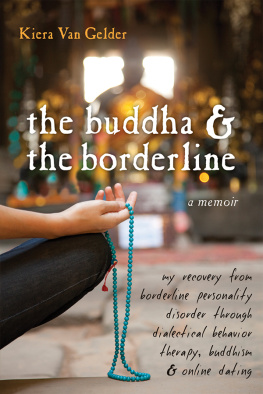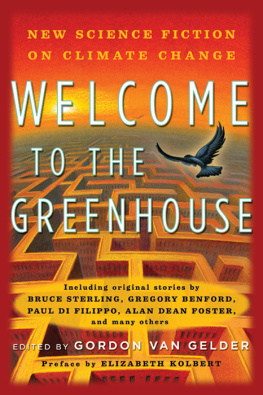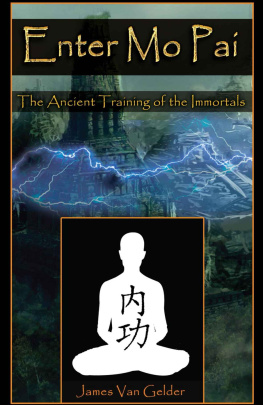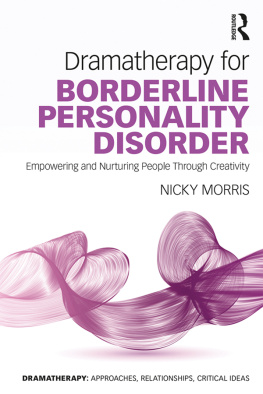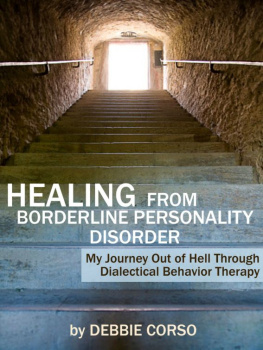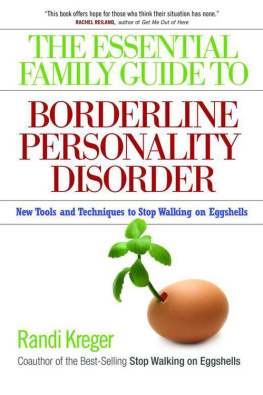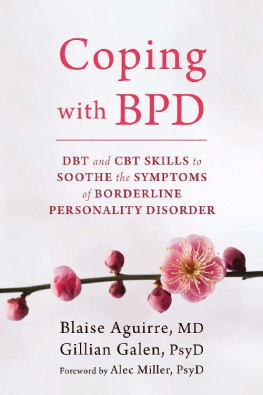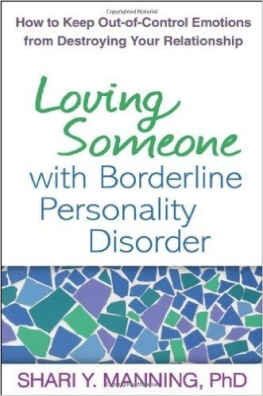Acknowledgments
This book could never have been written without the incredible dedication, kindness, and generosity of so many people. My deepest thanks to my editors Catharine Sutker, Heather Garnos, and Jess Beebe, and all those at New Harbinger who believed in the vision of this book and brought it to fruition, and to Jasmine Star, copyeditor extraordinaire, for the clarity and grace she gave my writing despite my howls of protest, and for her dedication and gentle hand along the way.
I am also grateful for the friendship, encouragement, and collaboration of so many extraordinary clinicians, in particular Dr. Blaise Aguirre, Dr. Seth Axelrod, Dr. Loren Crabtree, and Dr. Roy Krawitz. Thanks as well to the New England Personality Disorder Association (NEPDA), the National Education Alliance for Borderline Personality Disorder (NEABPD), the NAMI Greater Boston Consumer Advocacy Network (NAMI GB CAN), and the Transformation Center (and especially Howard Trachtman and Moe Armstrong), for all your support and guidance.
To Dr. Matthew Leeds and Dr. Martha Sweezy, thank you for teaching me the DBT skills and IFS techniques and providing me and countless others with the tools to rebuild our lives, and to Dr. Marsha Linehan, the founder of DBT, my deepest appreciation and admiration for all that youve done in bringing compassion and skillful means to the BPD diagnosis.
To Richard Tabors, Gail Hickey, and the TCA gang, thank you for raising me from a fledgling receptionist into an office goddess, and for formalizing my position as artist-in-residence by providing me with the perfect office suite with a view for writing the first half of this book. To the GMA team, who allowed me to be the only receptionist in Boston with a corner office, and who did everything possible to keep me on the path to completion, from disabling my online dating accounts, to sending me cards when I ran off to write on retreat, to filling the copy machine paper while I was too busy revising a paragraph for three hours. I could not have asked for more supportive coworkers and employers. Now that this book is done, I promise Ill make more smoothies.
To Will Turano and the Turano family, thank you for your unconditional love. To Colleen Favier, who still checks the New Yorker looking for my poems, for your unwavering faith in my talent, and to Jan Waldron, my writing teacher and inspiration, for teaching me that a memoirs power is equal to its honesty.
Thanks to my friends who arrived at the exact perfect moments: Charlene, Lana, and Lola Dickson, with your homemade chai and puppy love; Peter Munoz-Bennet, whose check-ins and car rides kept me on track; and Chris Martiniano, for seeing me through the longest nights with song, poetry, and pixilated presents. And to the Starbucks crew at the Kendall MarriottBarbara, Cisco, Dragana, Marta, and Sandrathank you for giving me life and smiles each morning.
To my dear readers Shannon Lemay-Finn and Zach Larson, my gratitude for lending your talents as writers and editors to this book from beginning to end, and especially to Rosanna Alfaro, who has cheered me on since I was a wee girl at Groton and declared even then that this day would come. To Scott Edelstein, my agent, guide, and reality-checker; without your help Id surely be sitting in a corner, clutching a handful of papers and babbling to myself. And to Randi Kreger, who reached out, flung open the doors to this book, and advised, cajoled, and comforted me along the way: your support has been invaluable.
To Diane and Jim Hall, thank you for your tireless work and for championing all who suffer from BPD. To Dr. Dixieanne Penney, mentor, friend, and colleague, you have been at my side throughout, even keeping the phone under your pillow, just in case. I am so grateful for my courageous BPD sisters on the front line: A.J. Mahari, Lisa Dietz, Amanda Wang, and Tami Green. Its been through your friendship and example that Ive learned to value my own voice and not fear the risk of this exposure. And to Amanda Smith, founder and executive director of the Florida Borderline Personality Disorder Association, you have been my touchstone and companion every step of the way with this book, bringing me back from the edge sometimes on a daily basis. Without your brilliant mind and unwavering love, this book and I would not have survived.
To Shyalpa Rinpoche and the Nyingma Longchen Nyinthig Lineage and to Lama Konchok Sonam Rinpoche, Khenpho Choephel Rinpoche, and the Drikung Kagyu Lineage, my endless gratitude for opening me to the true nature of my mind, and to the Drikung Meditation Center and all those in my Sangha, especially Mary Burke, Tia Harrison, Barbara Creamer, and Dotty Spoor, you have given me a community and a home, and have cradled me in your wisdom and compassion. My deepest thanks to my family, who instilled in me the supreme value of kindness, for your love, care, and courage to grow with me. And to Alexis Tsapatsaris, President of the Drikung Meditation Center, nemesis, Bodhisattva, and heart sister, your talent for opening up a can of whoop ass is only exceeded by your immense compassion.
To Raymond Hartman and Renee Rushnawitz, your generosity and love have provided the means to making this book, and my own recovery, a reality. Even in my dreams, you wait for me with outstretched arms. And finally, to Dr. Saul Rosenthal (who will never take credit for anything but has been with me through this entire journey), I can only repay you by living what you have taught me.
Completed on Losar, Year of the Iron Tiger, 2137. May this book benefit all beings!
Kiera Van Gelder, MFA, is an artist, educator, and writer diagnosed with borderline personality disorder. An international speaker and advocate, she is featured in the documentary Back from the Edge: Living With and Recovering From Borderline Personality Disorder. She currently lives in Massachusetts at a Buddhist meditation center. For additional information, please visit www.BuddhaAndTheBorderline.com and www.kieravangelder.com.
1
Beginnings have never been too hard for me: to shape the words of a first line or to choose the right outfitto pull off a good first act. For me, its always after the entrance that things deteriorate, especially in relationships. Fifteen years after the episode with Jimmy, Ive pulled myself together somewhat. No more drinking until I puke in mens laps. No more taking bottles of pills and being hospitalized. If you met me, youd never suspect the suicide attempts, hospitalizations, and diagnoses. But if you saw me in a relationship, youd know something isnt quite right. Im always good in the beginning, but after that first flush of romance, my lipstick will be smeared like a clowns and Ill revert to the dismay of a child lost in the department store, curled up and wailing on the floor.
Its no different with Bennet, who I meet when Im thirty. Hes a musician and a carpenter, with a lanky body habitually clothed in jeans and T-shirts, his pointy hipster sideburns and flop of brown hair making him seem boyish, even though hes almost a decade older than I am. When we meet, Im wearing a corset, a latex skirt, and black platform boots, which would be appropriate for a night club, but not the Narcotics Anonymous (NA) convention dance were both attending. Bennet, however, isnt fazednot by my outfit, and not when I say to him, You know Im fucked-up.
We both are, he grins. Who here isnt a mentally ill, suicidal drug addict? He gestures around the auditorium. We leave the dance, walk through the parking lot, and end up on a small plot of grass with a single tree. We hold each other for an hour and kiss, and since weve discovered each other at NA, where its often easy to mistake honesty for sanity, having sex seems like a reasonable thing to do.

